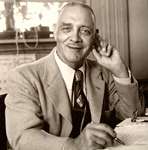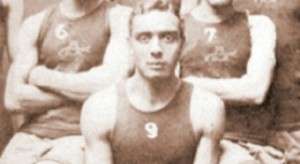In 1906, many white Americans believed black Americans didn’t do well at sports. An African-American physical education teacher named Edwin Henderson would spend the next 60 years proving them wrong.
He was at Harvard that year, learning to coach basketball. It was then a new game invented just 15 years earlier by Dr. James Naismith in Springfield, Mass. Naismith’s teacher, Luther Gulick, didn’t think anyone but white people could play it. “Games demanding team play are played by the Anglo-Saxon peoples, and by these peoples alone,” Gulick said.
People also believed that black athletes didn’t excel at distance running because they lacked discipline.
Henry Cabot Lodge, U.S. senator from Massachusetts, thought sports were just for white people. He told the Harvard Class of 1906 “…the time given to athletic contests… (is) part of the price which the English-speaking race has paid for being world-conquerors.”
Edwin Henderson
Edwin Henderson thought differently. He believed athletic competition enabled African-Americans to show their quality of character, and he enlisted athletic achievement in the crusade for equal opportunity. He wanted black athletes to win scholarships at predominantly white college in the North.
Basketball was largely unknown in the South, where Edwin Henderson was born in 1883. He graduated first in his class at Miners Teachers College in Washington, D.C., where in 1904, he got a job as a physical education teacher. He attended Dr. Dudley Sargent’s School of Physical Education at Harvard for three summers.
Sargent, a medical doctor, taught physical training for many years at Harvard. (The university denied him a professorship because he served on the faculty committee that banned football, then a rough, brawling game.)
Then when Edwin Henderson returned to Washington, D.C., he started a basketball league that played against clubs on the Eastern Seaboard. He taught Duke Ellington how to play basketball. He also taught Charles Drew, who won an athletic scholarship to Amherst College. Drew then became a medical doctor and developed large-scale blood banks at the beginning of World War II, saving thousands of lives.
The Power of Sports
Henderson also started the Eastern Board of Officials, which trained highly qualified African-American referees. For many years he headed of the Department of Physical Education in Washington, D.C.’s segregated school system. He campaigned to break down the restrictions of the local branch of the American Athletic Union on interracial competition.
Henderson came to believe in the power of sports to break down prejudice – and that star athletes instilled more pride in African-Americans than black musicians, artists or writers.
Quiet and modest with a good sense of humor, he was a prolific writer. For 60 years he wrote more than 3,000 letters to the editor protesting discrimination against African-Americans in sports competition, restaurants and theaters. During his long career promoting physical education among black students, he fought for civil rights. He started the first NAACP chapter in Falls Church, Va.
Hall of Famer
In 1939 he wrote a book, The Negro in Sports, commissioned by Carter Woodson, the Harvard-trained Ph.D. known as the father of black history. Henderson extolled the success of African Americans in intercollegiate sports at white colleges. He described how Matthew Bullock played football and ran track at Dartmouth. At Amherst and Harvard, William H. Lewis became the first black All-American in football. Ted Cable also starred in track at Harvard. Ernest Marshall, a Williams graduate, coached football before entering medical School.
William Tecumseh Sherman Jackson also excelled at Amherst. Later, as a high school teacher, he convinced Charles Hamilton Houston to attend Amherst. Houston then earned a law degree, and his legal victories won him the nickname “The Man Who Killed Jim Crow.”
On Feb. 5, 1974, Edwin Henderson was inducted into the National Black Sports Hall of Fame in New York City, along with Bill Russell, Muhammed Ali and Jackie Robinson.
“I never consciously did anything to be first. I just happened to be on the spot and lived in those days when there were few people doing those things which I was doing,” he once said.
Edwin Henderson died in 1977, at age 93.
This story was updated in 2022.
.



2 comments
[…] In 1906, many white Americans believed black Americans were poor at sports. An African-American physical education teacher named Edwin Henderson was at Harvard that summer learning to coach basketball. He would spend the next 60 years proving them wrong. Click for more. […]
[…] years into their marriage, the couple moved to Amherst, Mass., so David could take a job at Amherst College as astronomy […]
Comments are closed.